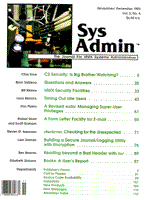
Sidebar: Excerpt from the SAGE Job Description Document
Organizations that rely on computing resources to carry out their mission have always depended on systems administration and systems administrators. The dramatic increase in the number and size of distributed networks of workstations in recent years has created a tremendous demand for more, and better trained, systems administrators. Understanding of the profession of systems administration on the part of employers, however, has not kept pace with the growth in the number of systems administrators or with the growth in complexity of system administration tasks. Both at sites with a long history of using computing resources and at sites into which computers have only recently been introduced, systems administrators face perception problems that present serious obstacles to their successfully carrying out their duties. Systems administration is a widely varied task. The best systems administrators are generalists: they can wire and repair cables, install new software, repair bugs, train users, offer tips for increased productivity across areas from word processing to CAD tools, evaluate new hardware and software, automate a myriad of mundane tasks, and increase work flow at their site. In general, systems administrators enable people to exploit computers at a level which gains leverage for the entire organization. Employers frequently fail to understand the background that systems administrators bring to their task. Because systems administration draws on knowledge from many fields, and because it has only recently begun to be taught at a few institutions of higher learning, systems administrators may come from a wide range of academic backgrounds. Most get their skills through on-the-job training by apprenticing themselves to a more experienced mentor. Although the system of informal education by apprenticeship has been extremely effective in producing skilled systems administrators, it is poorly understood by employers and hiring managers, who tend to focus on credentials to the exclusion of other factors when making personnel decisions. Understanding system administrators' background, training, and the kind of job performance to be expected is challenging; too often, employers fall back into (mis)using the job classifications with which they are familiar. These job classification problems are exacerbated by the scarcity of job descriptions for systems administrators. One frequently used misclassification is that of programmer or software engineer. Although the primary responsibility of the systems administrator is not to produce code, that is the metric by which programmers are evaluated, and systems administrators thus classified often receive poor evaluations for not being "productive" enough. Another common misclassification is the confusion of systems administrators with operators. Especially at smaller sites, where systems administrators themselves have to perform many of the functions normally assigned (at larger sites) to operators, systems administrators are forced to contend with the false assumption they are non-professional technicians. This, in turn, makes it very difficult for systems administrators to be compensated commensurate with their skill and experience.
|